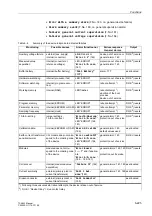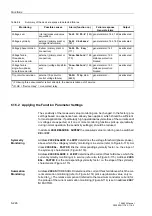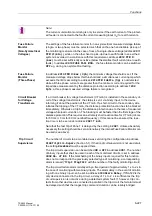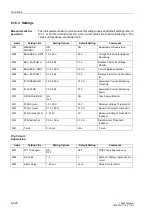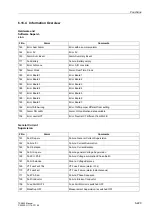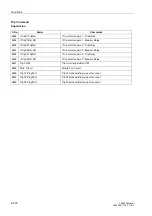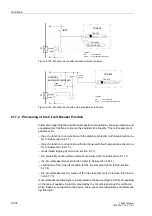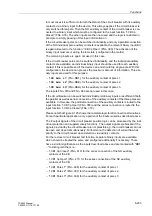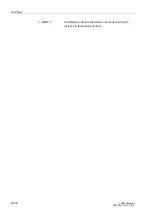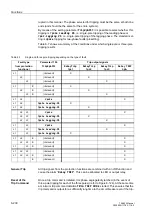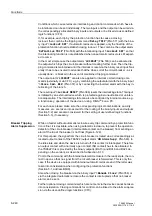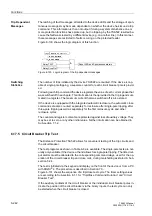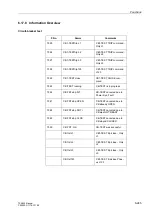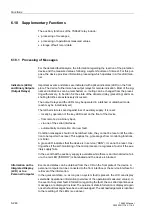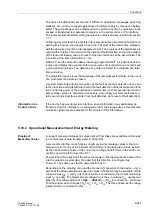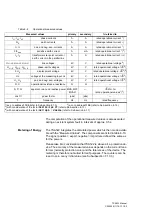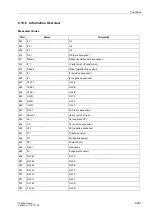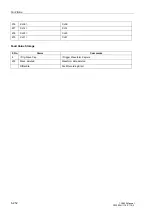
Functions
6-237
7SA522 Manual
C53000-G1176-C119-2
6.17.4 Overall Tripping Logic of the Device
Three-Pole
Tripping
In general, the device trips three-pole in the event of a fault. Depending on the version
ordered, (13th position of the ordering code = “4”) single-pole tripping is also possible
(see below). If, in general, single-pole tripping is not possible or desired, the output
function “
5HOD\75,3SK
” is used for the trip command output to the circuit break-
er. In these cases the following sections regarding single-pole tripping are not of inter-
est.
Single-Pole
Tripping
Single-pole tripping only makes sense on overhead lines, on which automatic
reclosure shall be carried out and where the circuit breakers at both ends of the line
are capable of single-pole tripping. In such cases, the faulted phase may be tripped
single-pole and subsequently reclosed; in the case of two-phase and three-phase
faults with or without earth, three-pole tripping is usually carried out.
Device prerequisites for phase segregated tripping are:
•
that phase segregated tripping is provided by the device (according to the ordering
code);
•
that phase segregated tripping is provided by the protection function which trips (ac-
cordingly not e.g. earth fault protection, high-current switch-on-to-fault protection,
overvoltage protection);
•
that the binary input “
!S7ULS3HUP
” is configured and activated or the internal
automatic reclosure function is ready for reclosure after single-pole tripping.
In all other cases tripping is always three-pole. The binary input “
!S7ULS3HUP
” is
derived from an external automatic reclose device and is equivalent to the logic inver-
sion of a three-pole coupling signal. This signal is present as long as the external
reclosure is ready for single-pole automatic reclosure.
With the 7SA522, it is also possible to trip three-pole when only one phase is subjected
to the trip conditions, but more than one phase indicates a fault detection. With dis-
tance protection this is the case when two faults at different locations occur simulta-
neously but only one of them is within the range of the fast tripping zone (Z1 or Z1B).
This is selected with the setting parameter
, which is set to
ZLWK
3,&.83
(every multiple-phase
fault detection
causes three-pole trip) or
ZLWK75,3
(in the event of multiple-phase
trip
commands the tripping is three-pole).
The tripping logic combines the trip signals from all protection functions. The trip com-
mands of those protection functions that allow single-pole tripping are phase segre-
gated. The corresponding alarms are “
5HOD\75,3/
”, “
5HOD\75,3/
” and
“
5HOD\75,3/
”.
These alarms can be allocated to LEDs or output relays. In the event of three-pole trip-
ping all three alarms pick up.
For the local display of fault event messages and for the transmission of event mes-
sages to a personal computer or a centralized control system, the device also provides
a summarized image of the trip signals, e.g. “
5HOD\7ULSS/
”, “
5HOD\7ULS
S/
”, “
5HOD\7ULSS/
” for single-pole tripping as well as “
5HOD\7ULSS
” for
three-pole tripping. Only one of these alarms appears at a time. These alarms are also
intended for the trip command output to the circuit breaker.
Single-Pole
Tripping with
Two-Phase Faults
Single-pole tripping for two-phase faults is a special feature. If a phase-phase fault
without earth occurs in an earthed system, this fault can be cleared by single-pole trip
and automatic reclosure in one of the faulted phases, as the short-circuit path is inter-
Summary of Contents for siprotec 7SA522
Page 20: ...7SA522 Manual C53000 G1176 C119 2 ...
Page 64: ...7SA522 Manual C53000 G1176 C119 2 ...
Page 89: ...SIPROTEC 4 Devices 4 25 7SA522 Manual C53000 G1176 C119 2 Figure 4 20 CFC Logic example ...
Page 408: ...7SA522 Manual C53000 G1176 C119 2 ...
Page 456: ...7SA522 Manual C53000 G1176 C119 2 ...
Page 516: ...7SA522 Manual C53000 G1176 C119 2 ...
Page 620: ...Appendix B 48 ...



